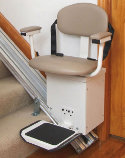What Are Stair Lifts?
Author: MedicalMan Published Under: Health

Stairs are a common part of many homes and greatly improve the usage of space within a home by allowing for multiple stories to be built on top of one another and easily accessed. Stairs allow multi-level homes to be built without the need for an elevator, which can be quite expensive, while still allowing full access to each floor in the home. However, for the elderly, using the stairs can be very difficult and is a common cause of falls, often resulting in serious injuries. Since the stairs can be so dangerous and hard to use, primarily among the elderly, a stair lift often provides an inexpensive alternative to installing a home elevator.
The concept for the stair lift actually dates back around 90 years, to the early twentieth century. It was then that a man whose neighbor was unable to use the stairs developed a special lifting system that helped carry his neighbor up the staircase. The device he invented was actually likely the first stair lift ever built, however it wouldn't be until considerably later the use of stair lifts became more common place.
Today, stair lifts remains fairly similar across most different manufacturers. Usually on straight staircases, a metal track is attached to the staircase, with a plastic chair that moves along the track. The chair is controlled by a simple control system, usually with only joystick that can move the chair either up or down the track. The chair itself is moved by an electric motor that is located in the base of the chair, with the base also containing rechargeable batteries on battery powered stair lifts.
Curved staircases usually use a stair lift that is similarly designed, but for staircases that are actually curved, as opposed to those that have a 90 degree bend, the metal track must be custom made to fit the curve of the stairway. For stairways with 90 degree bends, on the other hand, there are several stair lift kits available that are designed to be easily installed and work with most of these "L" shaped staircases. These can be used with staircases that have landings, as well as those with only "L" shaped bends. In areas of limited space, or on most curved staircases, the track is attached to the wall. Since the track is custom built, true curved stair lifts are much more expensive than those used on straight staircases.
Stair lifts are either powered directly or using battery power, with battery powered stair lifts, or DC Stair Lifts, costing a little more. However, this cost comes with the advantage of still allowing the stair lift to function even during a power disruption. One thing to keep in mind when considering the cost of a DC stair lift is that the batteries will need to be periodically replaced. Usually they last between 12 and 18 months, while costing around $50 to $100 to replace.
AC Stair Lifts, on the other hand, have a lower cost up front, but will not work when there is no power in the home. This can make them seem attractive, but it is important to understand that during an emergency, it will not work.
Using a stair lift is an excellent means of making the stairway safer and more accessible for the elderly. They are much less expensive than an elevator and can also often be installed without having to majority modify the home.